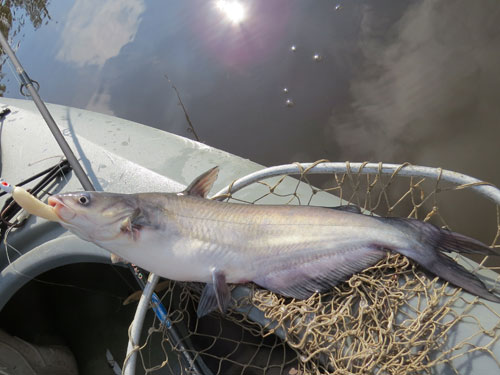
The blue catfish is the largest American catfish, occasionally exceeding 100 pounds. Although not native to the Mid Atlantic region, blue catfish have been stocked in lakes, reservoirs, and rivers.
Although large adults are instantly recognizable, juvenile blue cats are sometimes confused with channel catfish. The most common method for distinguishing the two species is to note the shape of the anal fin. Channel catfish exhibit a curved anal fin while blue cats have a straight-edged anal fin.
Blue catfish under ten pounds are commonly caught using the same baits and techniques that anglers use for other catfish species. Small to medium blue catfish also take artificial lures. They are often caught by anglers casting or jigging for largemouth bass or other species.
Fishing for trophy-class blue catfish is accomplished by fishing live or cut baits in areas where large catfish are known to lurk. In most locations, local forage fish are the most popular baits for catching large blue catfish. Live baits for blue catfish include gizzard shad, threadfin shad, alewives, golden shiners, suckers, and other mid-sized baits.
Blue catfish can be caught during the day, but some of the best fishing occurs during early morning, around sunset, and after dark.
Several bodies of water in the Mid Atlantic are known for their populations of trophy class blue catfish, including the James River, Potomac River, Buggs Island Lake, Lake Norman, and others.
Despite their popularity among anglers, Maryland announced in 2012 that it was classifying blue catfish as an invasive species and began considering eradication efforts.
Efforts to limit the spread of blue catfish throughout the Chesapeake Bay watershed proved unsuccessful and the species is now firmly established in many rivers and other tributaries.